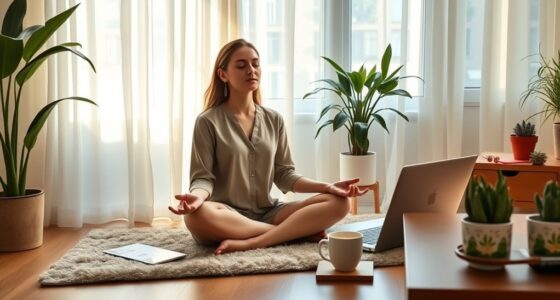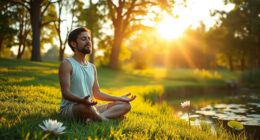To reduce anxiety, try mindfulness exercises like focused breathing, where you take deep breaths to activate your relaxation response, or use guided imagery to picture peaceful scenes and quiet your mind. Incorporate body scans to become aware of physical sensations and notice tension. Moving mindfully during activities like walking or stretching can also help. Establishing a daily routine of these practices builds resilience over time. Keep exploring these techniques to discover how they can best support your calmness.
Key Takeaways
- Practice deep abdominal breathing to activate the relaxation response and reduce anxiety symptoms.
- Use guided imagery to visualize calming scenes, engaging senses to distract from stressors.
- Conduct body scan meditations to increase awareness of physical sensations and identify tension early.
- Incorporate mindfulness into physical activities like yoga, running, or cycling to enhance focus and emotional regulation.
- Establish a daily mindfulness routine with brief exercises to build resilience and promote long-term anxiety management.
Breathing Techniques to Calm Your Mind
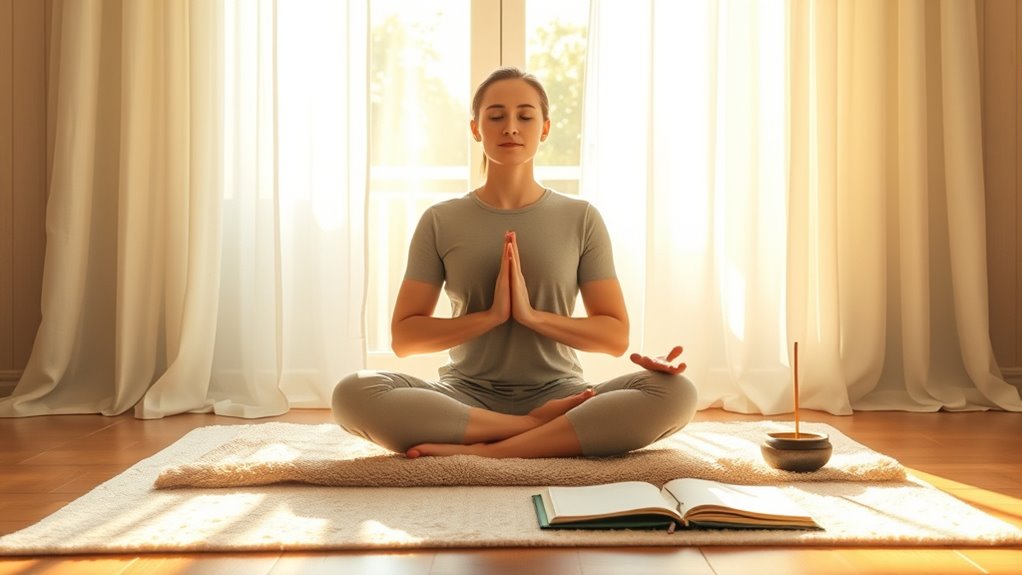
Breathing techniques are simple yet powerful tools for calming your mind and reducing anxiety. When you focus on your breath, you activate your nervous system’s relaxation response, helping to ease tension. Incorporating deep abdominal breathing into your routine can significantly enhance its calming effects. You can practice these exercises anywhere—whether you’re sitting in a chair, lying on your bed, or standing. Regular practice deepens their calming effect, making it easier to manage stress when it arises. Many techniques emphasize deep abdominal breathing, which helps slow your heart rate and lower blood pressure. For example, inhaling deeply through your nose and expanding your belly, then exhaling slowly through your mouth, can quickly bring you back to a calmer state. These practices are free, accessible, and use only your own breath to help you find calm amid chaos.
Guided Imagery for Relaxation
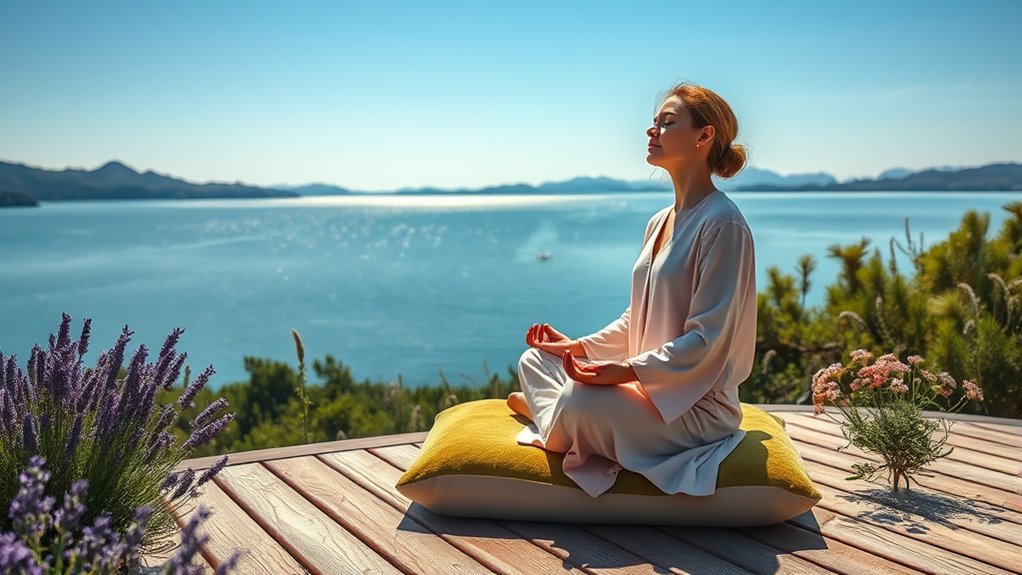
Have you ever wondered how your mind can transport you to a peaceful place even during stressful moments? Guided imagery helps you do just that. By engaging your senses and focusing on vivid mental scenes, you can reduce anxiety and release physical tension.
Imagine yourself on a quiet beach or walking through a lush forest, incorporating sights, sounds, smells, and textures to make the scene real. This technique creates a calming mental environment that fosters serenity and manages stress effectively. Variety of materials available can enhance the sensory experience and personalization of your visualization.
To practice, sit or lie comfortably, breathe deeply, and visualize your peaceful scene with detailed sensory input. Maintaining focus on this mental image allows you to shift attention away from stressors, promoting emotional balance and mental clarity. Incorporating city dynamics understanding can help you better adapt and find calmness in various environments, even during busy or stressful times. Developing mindfulness skills through these exercises can further deepen your relaxation and resilience, especially when combined with an understanding of contrast ratio and its impact on visual clarity.
Body Scan Meditation Practices

Body scan meditation is a powerful mindfulness practice that helps you become more aware of physical sensations throughout your body. It shifts your focus from racing thoughts to bodily experiences, reducing anxiety and stress. Understanding store hours can help you plan your meditation sessions more effectively, ensuring you have dedicated time without interruptions. You can practice in various positions—lying down, sitting, or standing—making it flexible to fit your routine. This exercise enhances self-awareness, allowing you to recognize tension and emotional states as they arise. Incorporating mindfulness techniques into your routine can further deepen your experience and effectiveness. Regular practice trains your nervous system to relax, leading to improved mood, better sleep, and pain management. Exploring the benefits of sound healing science can provide additional tools for relaxation and emotional balance. Using portable camping gear such as comfortable mats or cushions can make your practice more enjoyable and accessible outdoors. Developing a consistent routine can also help establish effective stress relief habits that support your mental health. Guided sessions often focus on different body parts, helping you stay present. Whether short or extended, body scan meditation offers a simple yet effective way to foster relaxation and mental clarity anytime you need it.
Incorporating Mindfulness Into Physical Activities
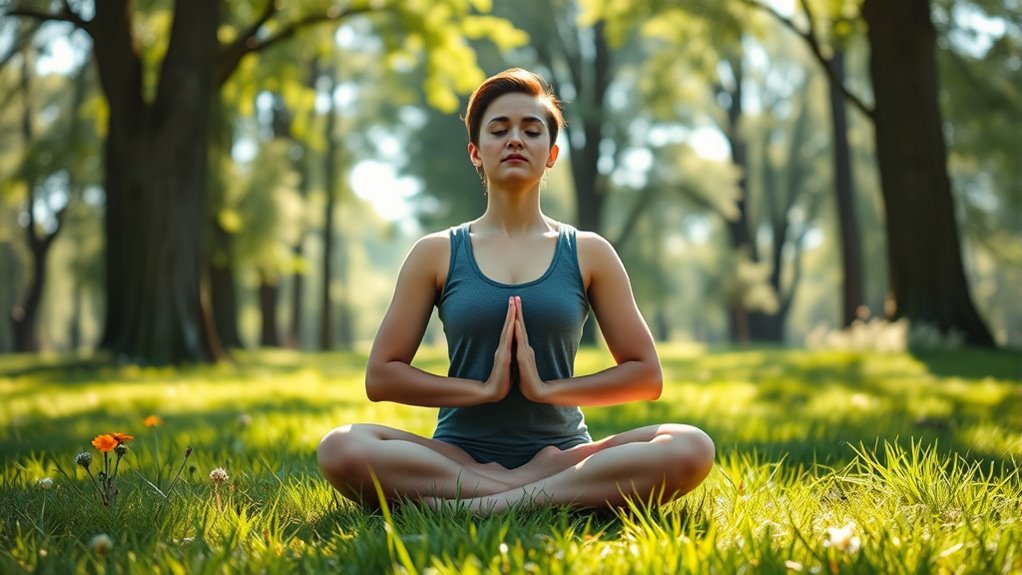
Incorporating mindfulness into physical activities transforms ordinary movement into a powerful tool for anxiety relief. When you walk mindfully, focus on each step, notice your surroundings, and pay attention to your breathing. This helps improve balance and coordination while calming your mind. Engaging in mindfulness exercises during physical activity can deepen your sense of presence and relaxation. During yoga and stretching, stay aware of body sensations, tension, and relaxation, using your breath as an anchor. When running or jogging, synchronize your breath with your footsteps and engage your senses to stay present, boosting endurance and mental resilience. Even in team sports or cycling, maintaining focus on the activity, physical sensations, and scenery enhances awareness and reduces stress. Incorporating mindful movement practices can also help develop better body awareness and promote overall well-being. Practicing focused attention during these activities can further enhance mental clarity and emotional stability. Additionally, incorporating physical activity into your routine can guide you toward healthier habits and resilience against anxiety triggers.
Building a Daily Mindfulness Routine
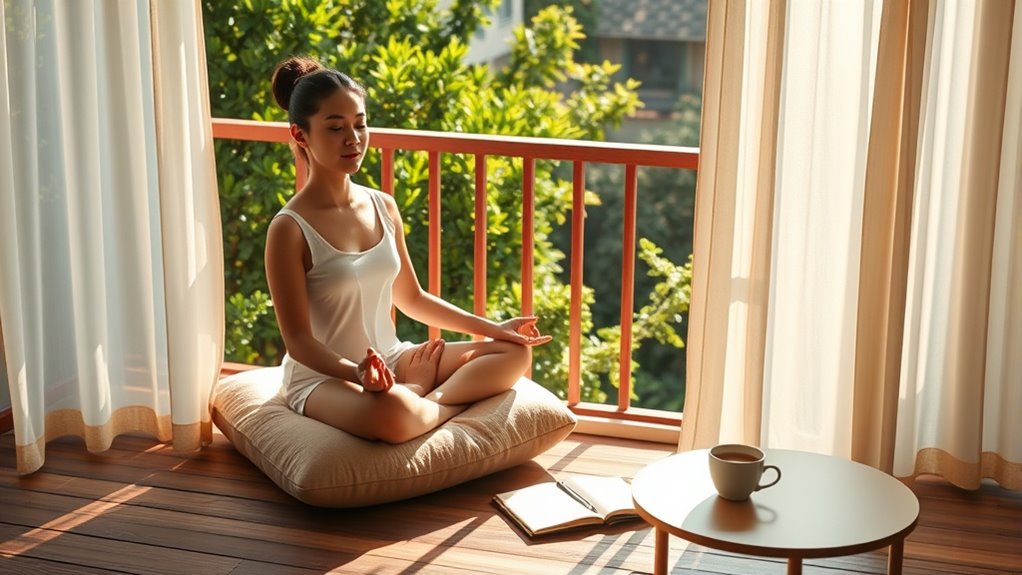
Establishing a daily mindfulness routine is essential for making its benefits a lasting part of your life. Consistency helps retrain your mind and body’s responses to stress, so practicing regularly—even when you’re not feeling anxious—cements these habits. Developing a personal growth mindset through regular mindfulness practice can lead to greater resilience and emotional balance. You can incorporate mindfulness anywhere, making it easy to include in daily routines. For example, start your mornings with breathing exercises or body scans to set a calm tone for the day. Incorporate short mindful moments during activities like walking or eating, or practice gentle yoga to combine movement with awareness. Building this routine enhances mindfulness’s effectiveness, helping you manage anxiety more effectively over time. Engaging in evidence-based techniques backed by psychological research can further optimize your practice. Recognizing the importance of mental health in overall well-being can motivate you to maintain consistency. Additionally, understanding Pimple Patch technology can serve as a reminder that targeted, effective practices—whether for skin or mental health—are vital for overall self-care. Incorporating consistent practices like mindful breathing or meditation can be especially helpful in reducing stress responses and promoting emotional stability. With commitment, you’ll find that these practices become second nature, supporting your mental well-being long-term.
Frequently Asked Questions
Can Mindfulness Exercises Replace Medication for Anxiety?
You might wonder if mindfulness exercises can substitute medication for anxiety. While they can be effective and offer long-term benefits, they often require consistent practice and may not provide immediate relief like medication.
If you prefer avoiding pharmaceuticals, mindfulness could be a good alternative or complement. However, it’s important to consult your healthcare provider to determine the best approach for your specific needs and guarantee safe, effective treatment.
How Long Does It Take to See Benefits From Mindfulness Practice?
You wonder how long it takes to see benefits from mindfulness practice. Typically, you can notice immediate effects like reduced stress after a single session.
With just ten minutes daily, you might start seeing improvements in mood and focus within 30 days.
Consistent practice over 45-60 days can lead to measurable brain changes.
Keep at it, and you’ll likely experience ongoing mental health benefits over time.
Are Mindfulness Techniques Suitable for Children and Teenagers?
You might wonder if mindfulness techniques suit children and teenagers. The good news is, they’re generally very effective when tailored to their age and needs.
Simple practices like breathing exercises, guided imagery, and mindful movement help kids and teens manage emotions, reduce stress, and improve focus.
With appropriate adjustments, mindfulness can be a valuable tool for young people to build resilience and foster overall well-being.
Can Mindfulness Help With Severe or Panic-Related Anxiety?
You’re wondering if mindfulness can help with severe or panic-related anxiety. The good news is, it can be effective, especially when combined with other treatments.
Mindfulness helps you focus on the present, manage stress responses, and regulate emotions, which are key during panic episodes.
Regular practice, possibly with guidance, can reduce symptoms over time and improve your ability to handle intense anxiety, even in severe cases.
What Are Common Challenges Beginners Face With Mindfulness Exercises?
You might find it hard to stay focused during mindfulness exercises because of internal thoughts or external noise. It’s common to get impatient or frustrated when results don’t come quickly.
Finding the time and creating a routine can also be tough, especially with a busy schedule.
Additionally, misconceptions or fear of doing it wrong can hold you back.
Conclusion
Practicing mindfulness can profoundly reduce anxiety—studies show that 43% of people practicing regularly experience less stress. By incorporating simple exercises like breathing techniques or body scans into your daily routine, you’re taking powerful steps toward calmer, clearer thinking. Remember, consistency is key; even a few minutes each day can make a real difference. Start today, and you’ll gradually build resilience against anxiety, leading to a more peaceful and focused life.




